Before I had even pressed my hands against her hull, I had seen my new motorboat in photos taken by her broker. Photos, of course, don’t really do a boat justice, much as photos of a storm at sea don’t capture the true essence of the tempest. Even the first time I climbed aboard her, in the presence of her owner and one of the men from the boatyard, I was preoccupied and distracted enough that I didn’t take her all in. But on this day, with remnants of late winter snow still on the ground, and with me all alone for some private time with the boat in the cavernous boat shed, she suddenly became very real.
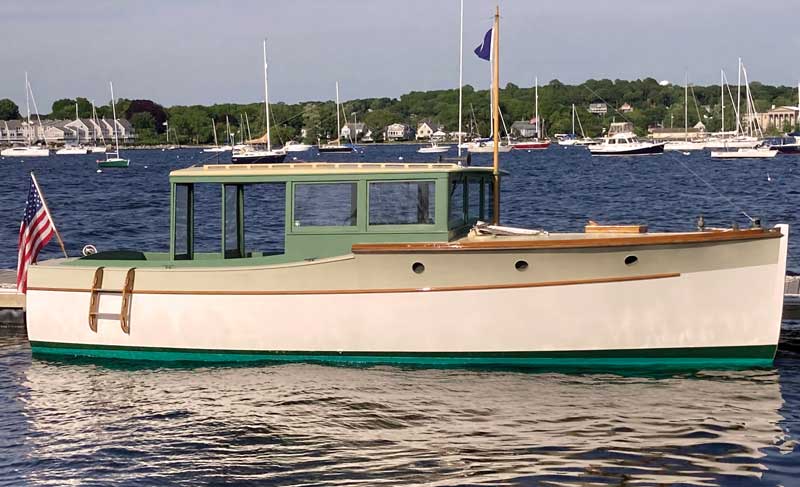
There is nothing comparable to a dimly lit, silent boat shed to make a boat stored within it appear massive and intimidating to a new owner, especially when she is up on blocks and stands. Other boats stood closely packed around her, and as I stood in front of her sharply flared bow and straight, sharp stem, I was slightly unnerved. Outside, the brilliance of the sunlit late spring snow had blinded me momentarily. There, the air smelled fresh with a faint hint of balsam; in the shed the air was damp and smelled of old wood, algae, and copper paint. I was soon ready to leave, but in a few weeks I would be back here, she would be launched, and I would be bringing her south nearly 300 nautical miles to her new home in Rhode Island waters; a different climate, a different world. I wondered, nervously, if I would be ready.
In truth, my new boat, named Tollie by her owner, was not terribly big at all. She was only 32-feet long, an antique wooden ‘Lobster Cruiser’ designed and built in Maine in 1928. I felt intimidated not by her size, although she was not diminutive, but by the enormity of the task ahead of me—the voyage, the unending responsibility that would come, the new life for the boat and for me. I did not recognize the face of this yet; all I felt was inexplicable anxiety. The boat, and everything about it, was a genie that, once out of the lamp, could never be coaxed back inside. She was the boat in the shed, the elephant in the room, the black bear in the doorway. I rubbed my hand along her painted hull; she felt strong and solid. So why then did I not feel reassured? Whence this timidity? I then consoled myself with the knowledge that it had been a few years since I’d owned a good boat, or even one in the water. “It will all come back to you,” I reassured myself, “once you start doing it again.”
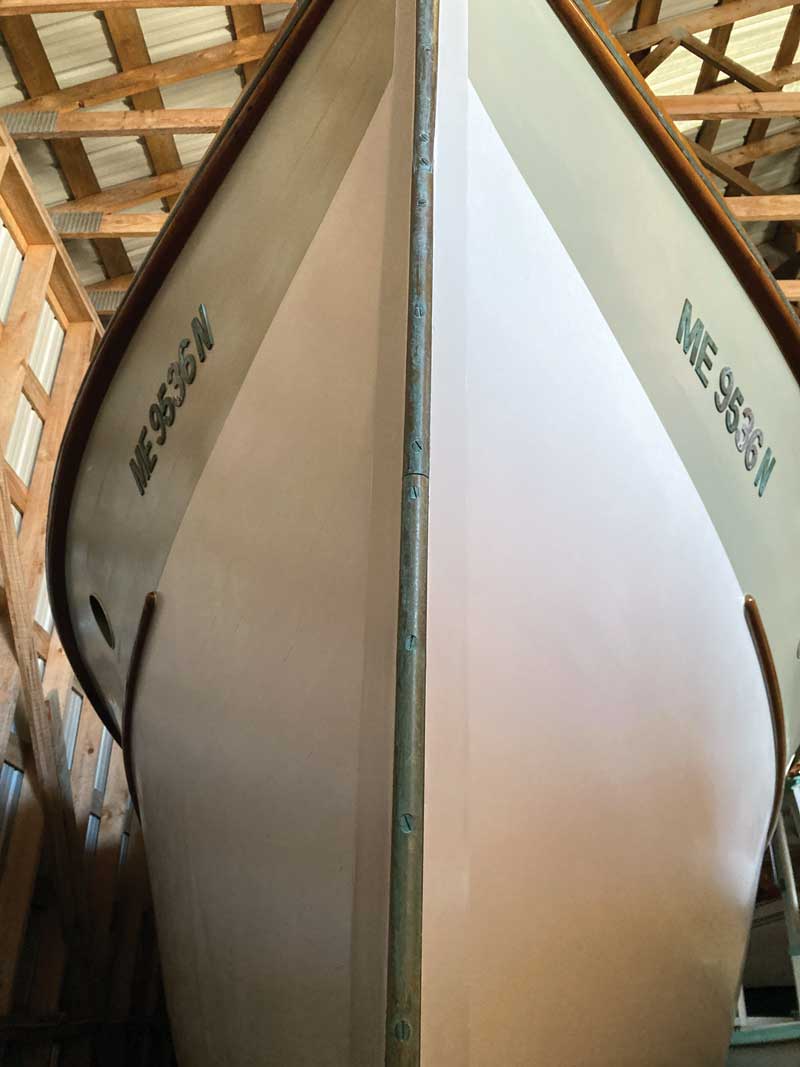
On a rainy, cloudy morning weeks later, in late May, I stood on the shore of the Benjamin River at the boatyard in Sedgwick, ME, gazing out in search of my boat on her mooring. A rickety dock on pilings high above the shore, with a long and impossibly steep ramp, led down to a float where the boatyard’s small launch waited, loaded with our gear, low to the gunwales with equipment, food, clothing, and fuel jugs. The air was foggy, murky, and misty, leaving a low-tide salt tang on the tip of my tongue. I searched the far shore carefully, and then finally saw her, riding contentedly on her mooring.
For the journey south I was accompanied by my long-time friend Captain Tom, a licensed Master and an engineer well-versed in all things diesel and mechanical, and my brother-in-law Joe, who had before his retirement been an airplane pilot. We had driven up in my pickup truck from Rhode Island a couple of nights before with a friend of Tom’s, whose paid job was to drive the truck home once we had departed on our way.
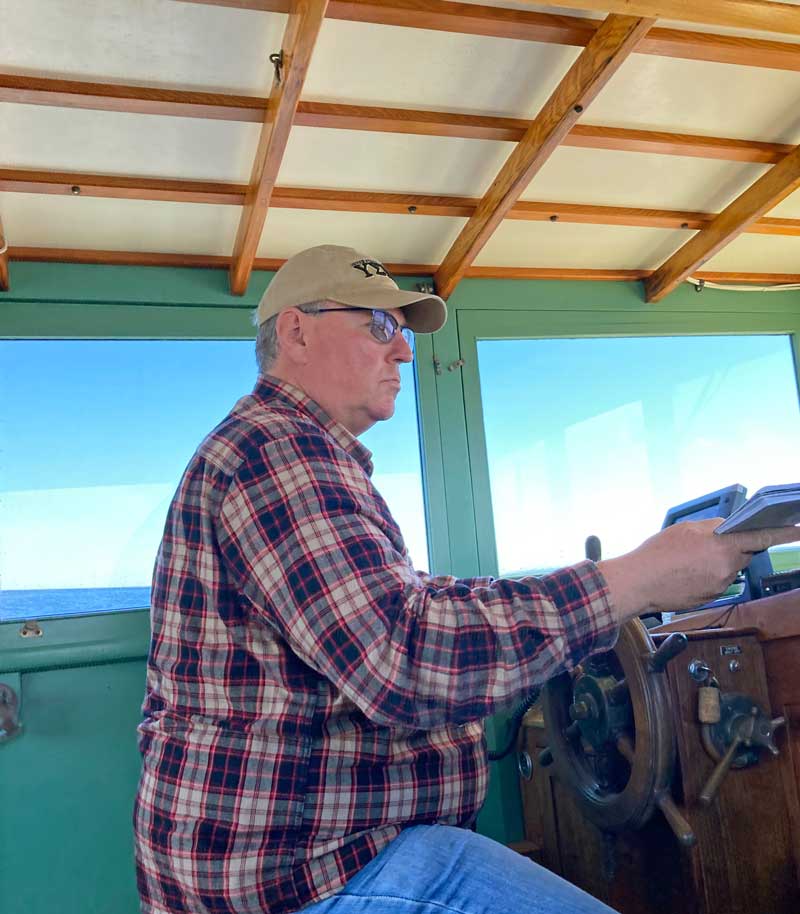
Once aboard the boat the next morning, the engine started, gear was stowed, and we slipped our mooring line and headed out into the river’s foggy mist, our destination being Stonington, ME, the fuel dock, and hopefully a place to tie up for the night at the end of the day. Stonington is a compact, ancient village at the southernmost end of Deer Island, a place as wild as any settled place in Maine, a geography of hilly terrain and winding roads, of homes occupied with windows lighted at night, but without a soul around to talk to.
This was, I thought, quintessential mid-coast Maine. We walked more than a mile to find a little restaurant at the edge of the village where, it seemed, on this night, everyone living on the island had gathered in the gray, settling darkness, drawn by the lights and sounds of the only public place open, noisy and brightly lit. We hiked back to the boat after dinner, where she lay dockside in the cold, damp, quiet harbor and passed a flask of whiskey around between us while watching the blinking lights of the buoys in the darkness out on the still waters. Once settled, with the canvas side curtains closed, the boat’s cabin still retained much of her engine heat, to be slowly released, and with light blankets we each slept comfortably even though the Maine night had grown quite chilly outside.
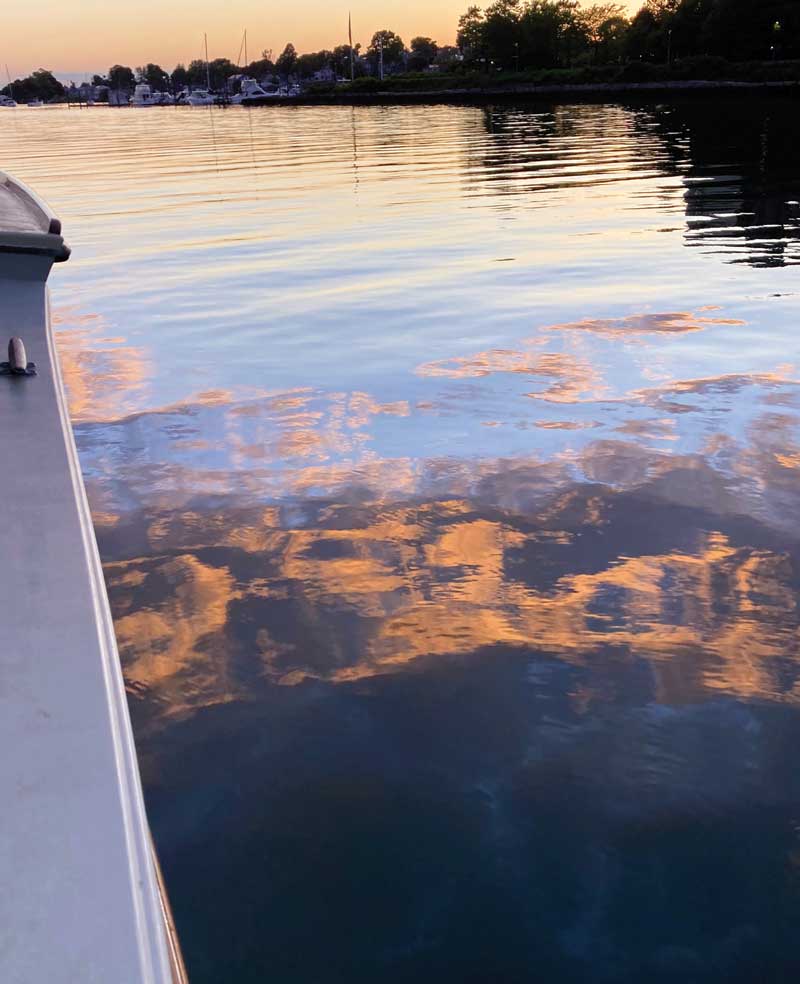
Morning came accompanied by bright sun, sharp blue skies and a crisp, cool dryness that promised a fine day for the run down to Penobscot Bay. I percolated a pot of coffee on the single-burner butane stove as we left. We made good time running with the tide in our favor, averaging nine knots over the ground. We weren’t sure where we would end up by evening, but with my chart and calculations, as well as some advance planning, I hoped that we would make Portland by nightfall, which, happily, we did.
The next day dawned gray with fog and lumpy seas, salty spray and chilly rain. The coast of Maine was shadowy in the distance, and the boat rolled uncomfortably as we all took turns at the wheel. A boat with a round bilge will be prone to rolling; the best strategy is to wedge oneself into a secure spot and hang on between turns at the wheel. At one point we passed lonely, isolated Boon Island and its solitary lighthouse. This tiny rocky islet off York has been the site of several shipwrecks beginning in the late 17th Century, including that of the Nottingham Galley, where survivors spent weeks in wintry weather with no shelter among the rocks but torn sails, and before the few survivors were rescued, they resorted to cannibalism, eating mussels and seaweed and the remains of the unfortunate ship’s carpenter. We were more than happy to give it a wide berth.
Having left Portland that morning, our tumultuous course took us past Boston and into Hingham Harbor at sunset to at last rest in quiet waters. I knew Hingham, since I had delivered a couple of boats into and out of that harbor, so familiarity brought some comfort and reassurance. In the inner harbor on water as flat as a mirror, we tied up dockside after hours to a marina’s now-closed fuel dock, ate food from our stores, and slept well, exhausted, but in warmer conditions than Maine had offered us. In the morning, we would take on fuel and make, hopefully, the fourth and final leg of our journey to Bristol.
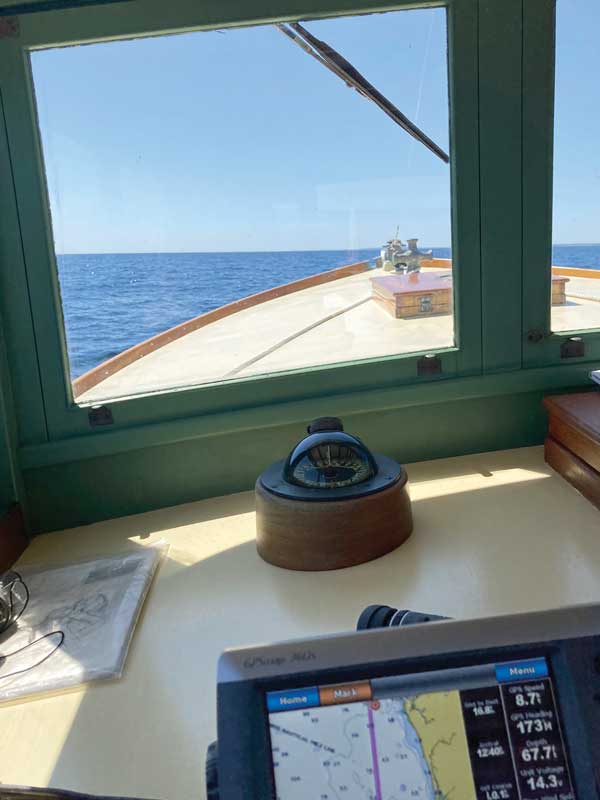
The final day of travel was a long one, eventually finding us in Bristol at the dock late in the evening and well after dark. We motored down Massachusetts Bay, past Plymouth, and made a slow transit against the tide through the Cape Cod Canal. With the canal it’s all about timing, and our timing was clearly off, but we kept at it anyway, eventually emerging into Buzzard’s Bay. Stemming the tide and with the brunt of a southwest wind in our teeth, it was a rough ride; the roughest part was the few miles of open water between Cuttyhunk Island and the mouth of the Sakonnet River. We pounded, we rolled, we had a miserable time of it, slammed by beam seas and rolled over almost onto her beam-ends. But at last, after sunset and as dusk was falling, we entered the calmer waters of the river, which were also very familiar waters, and I knew that if I could avoid hitting anything, we would probably make it home safely. The boat had no radar, which I thought unusual for a boat intended to operate in Maine waters, so we trusted the chartplotter and our three pairs of eyes, plus prudently low speeds, to get us home. As we turned the corner of Common Fence Point, we saw the venerable Mount Hope Bridge all dressed and strung in Fourth-of-July red, white, and blue lights, and such a beautiful sight was not to be seen anywhere else in Narragansett Bay! We passed under the bridge, and then turned toward Bristol Harbor, her new home.
Denise and I have re-named our boat Anna Mary, after our first grandchild (You can read more about her in the August PropTalk Classic Boat column and at proptalk.com/classic-boat-lobster-cruiser-anna-mary). Choosing this boat seems to have been the right choice indeed. She was a flush-deck style cruiser built of wood in 1928, but I loved the looks of her and knew that I would never see such a boat with such style created in fiberglass. She is powered by a Ford Lehman 120-hp six-cylinder marinized diesel dating from the 1980s, and with low overall hours. My crew and I brought her down from Maine running all day for four days with no issues, but with fresh fuel filters etc. Lehman diesels are known for their reliability. Trawlers and commercial fishermen use them frequently. She develops a lot of torque, and we can cruise around nine knots in just about any kind of water, faster if we need to. We run sweetly at 1700 rpm pushing hard at 2000 rpm. Cruising with guests, we are at around 1000 rpm and moving at a smooth and comfortable five knots. Our burn is three to four gph.
Now Anna Mary rests easy at the end of her double bridle on her mooring in Bristol Harbor. Due to her size, open roominess, and inherent seaworthiness, I have begun a little local touring and chartering business with her, titled Bristol Classic Cruises. Time will tell whether or not she and her captain will succeed at this venture, but for the time being, she is becoming well-loved around Bristol waters and those who cruise aboard seem to be happy with her.
By Capt. Michael L. Martel